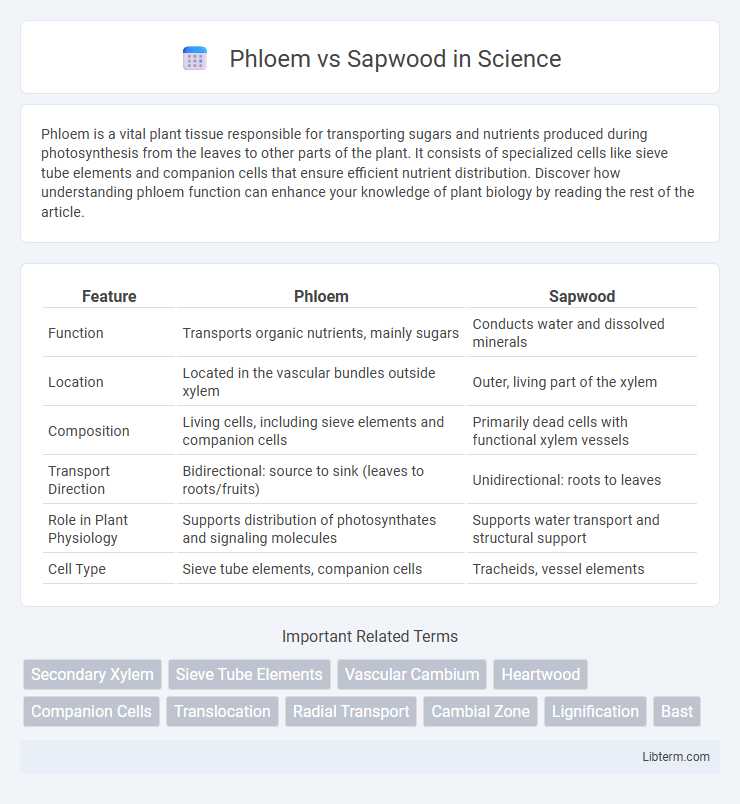Phloem is a vital plant tissue responsible for transporting sugars and nutrients produced during photosynthesis from the leaves to other parts of the plant. It consists of specialized cells like sieve tube elements and companion cells that ensure efficient nutrient distribution. Discover how understanding phloem function can enhance your knowledge of plant biology by reading the rest of the article.
Table of Comparison
| Feature | Phloem | Sapwood |
|---|---|---|
| Function | Transports organic nutrients, mainly sugars | Conducts water and dissolved minerals |
| Location | Located in the vascular bundles outside xylem | Outer, living part of the xylem |
| Composition | Living cells, including sieve elements and companion cells | Primarily dead cells with functional xylem vessels |
| Transport Direction | Bidirectional: source to sink (leaves to roots/fruits) | Unidirectional: roots to leaves |
| Role in Plant Physiology | Supports distribution of photosynthates and signaling molecules | Supports water transport and structural support |
| Cell Type | Sieve tube elements, companion cells | Tracheids, vessel elements |
Introduction to Phloem and Sapwood
Phloem is a vascular tissue in plants responsible for transporting organic nutrients, particularly sugars produced through photosynthesis, from the leaves to other parts of the plant. Sapwood, the younger, outermost wood of a tree, functions primarily in the conduction of water and minerals from roots to leaves through xylem vessels. Both phloem and sapwood are essential components of the plant's vascular system, enabling nutrient distribution and structural support.
Definitions: What Are Phloem and Sapwood?
Phloem is the vascular tissue responsible for transporting organic nutrients, primarily sugars, from leaves to other parts of the plant. Sapwood refers to the outer, living layers of secondary xylem that conduct water and minerals from roots to leaves while also storing nutrients. Both tissues are essential for plant growth and nutrient distribution, with phloem involved in nutrient translocation and sapwood in water conduction and storage.
Structural Differences Between Phloem and Sapwood
Phloem consists of living cells arranged in sieve tubes and companion cells responsible for transporting organic nutrients, primarily sugars, while sapwood is composed of dead xylem cells forming a rigid, tubular structure that conducts water and minerals. Phloem lies outside the cambium layer and is relatively softer, whereas sapwood resides inside the cambium, providing structural support due to its lignified, thick-walled tracheids and vessel elements. The cellular composition and function differentiate phloem's role in nutrient distribution from sapwood's role in mechanical strength and water conduction.
Location in Plant Anatomy
Phloem is located just outside the vascular cambium in the plant stem, functioning as the tissue responsible for transporting sugars and organic nutrients from leaves to other parts of the plant. Sapwood, found in the outer layers of the secondary xylem, primarily conducts water and minerals from roots upwards, supporting active growth and physiological processes. Both tissues are integral components of vascular tissue systems but serve distinct roles and occupy specific zones in plant anatomy.
Primary Functions: Transport and Support
Phloem primarily functions in the transport of organic nutrients, especially sugars produced through photosynthesis, from the leaves to various parts of the plant. Sapwood, the outer, living layers of secondary xylem, mainly supports water conduction from roots to leaves and provides structural support. Together, phloem and sapwood maintain the vital processes of nutrient distribution and mechanical strength essential for plant growth and survival.
Composition and Cellular Structure
Phloem consists primarily of sieve tube elements, companion cells, phloem fibers, and parenchyma, facilitating the transport of organic nutrients, especially sugars, throughout the plant. Sapwood, or xylem sapwood, is composed mainly of tracheids, vessel elements, fibers, and parenchyma cells, functioning primarily in the conduction of water and dissolved minerals from roots to leaves. The cellular structure of phloem is living at maturity, enabling active transport, whereas sapwood cells are mostly dead, providing structural support and water conduction.
Role in Plant Growth and Development
Phloem transports organic nutrients, primarily sucrose, from leaves to growing tissues, supporting cell division and expansion essential for plant growth. Sapwood, composed of active xylem, conducts water and minerals from roots to leaves, facilitating photosynthesis and nutrient distribution. Together, phloem and sapwood coordinate resource allocation critical for plant development and structural support.
Importance in Water and Nutrient Movement
Phloem plays a vital role in transporting organic nutrients, primarily sugars, from leaves to various parts of the plant, supporting growth and development. Sapwood, the living outer layer of xylem, is crucial for conducting water and dissolved minerals from roots to leaves, ensuring hydration and nutrient supply. Together, phloem and sapwood maintain the plant's internal transport system, facilitating essential nutrient distribution and water movement critical for survival.
Commercial Uses and Economic Significance
Phloem serves as a crucial component in the production of cork and natural fibers, which are widely used in packaging, textiles, and insulation, contributing significantly to industries like fashion and construction. Sapwood, known for its strength and durability, is extensively harvested for timber, furniture manufacturing, and paper production, driving substantial economic revenue in the forestry sector. Both phloem and sapwood play vital roles in agriculture and forestry, underpinning the sustainability and profitability of commercial timber and fiber markets.
Key Differences: Phloem vs Sapwood Summary
Phloem is the vascular tissue responsible for transporting organic nutrients, primarily sugars, from the leaves to other parts of the plant, whereas sapwood is the outer, living part of the xylem that conducts water and minerals from roots to leaves. Phloem cells are located just outside the cambium layer, while sapwood consists of active xylem vessels situated beneath the bark and outside the heartwood. Unlike sapwood, which provides structural support and water conduction, phloem primarily functions in nutrient distribution and signaling within the plant.
Phloem Infographic

 libterm.com
libterm.com